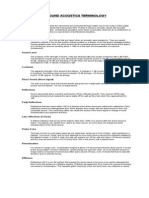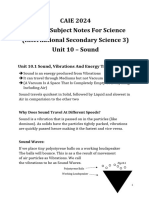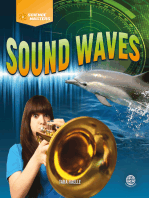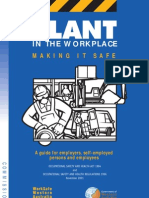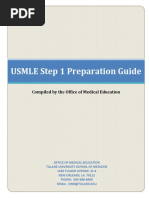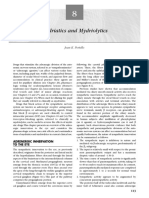0 ratings0% found this document useful (0 votes)
14 viewsSound PPT-3
Sound PPT-3
Uploaded by
prabhavkalsiThe document discusses various topics related to sound:
1. Sound can be reflected or absorbed. An echo occurs when sound bounces off a surface and reaches our ears after a short delay.
2. Noise pollution is increasing due to vehicles and loud sounds. Excessive noise can cause health issues like hearing loss and headaches.
3. Steps like using sound barriers, limiting loud devices, and planting trees can help reduce noise pollution. Proper town planning is important to minimize noise impact on residential areas.
Copyright:
© All Rights Reserved
Available Formats
Download as PPTX, PDF, TXT or read online from Scribd
Sound PPT-3
Sound PPT-3
Uploaded by
prabhavkalsi0 ratings0% found this document useful (0 votes)
14 views23 pagesThe document discusses various topics related to sound:
1. Sound can be reflected or absorbed. An echo occurs when sound bounces off a surface and reaches our ears after a short delay.
2. Noise pollution is increasing due to vehicles and loud sounds. Excessive noise can cause health issues like hearing loss and headaches.
3. Steps like using sound barriers, limiting loud devices, and planting trees can help reduce noise pollution. Proper town planning is important to minimize noise impact on residential areas.
Copyright
© © All Rights Reserved
Available Formats
PPTX, PDF, TXT or read online from Scribd
Share this document
Did you find this document useful?
Is this content inappropriate?
The document discusses various topics related to sound:
1. Sound can be reflected or absorbed. An echo occurs when sound bounces off a surface and reaches our ears after a short delay.
2. Noise pollution is increasing due to vehicles and loud sounds. Excessive noise can cause health issues like hearing loss and headaches.
3. Steps like using sound barriers, limiting loud devices, and planting trees can help reduce noise pollution. Proper town planning is important to minimize noise impact on residential areas.
Copyright:
© All Rights Reserved
Available Formats
Download as PPTX, PDF, TXT or read online from Scribd
Download as pptx, pdf, or txt
0 ratings0% found this document useful (0 votes)
14 views23 pagesSound PPT-3
Sound PPT-3
Uploaded by
prabhavkalsiThe document discusses various topics related to sound:
1. Sound can be reflected or absorbed. An echo occurs when sound bounces off a surface and reaches our ears after a short delay.
2. Noise pollution is increasing due to vehicles and loud sounds. Excessive noise can cause health issues like hearing loss and headaches.
3. Steps like using sound barriers, limiting loud devices, and planting trees can help reduce noise pollution. Proper town planning is important to minimize noise impact on residential areas.
Copyright:
© All Rights Reserved
Available Formats
Download as PPTX, PDF, TXT or read online from Scribd
Download as pptx, pdf, or txt
You are on page 1of 23
SOUND
Reflection and Absorption of Sound- Echo& Sound absorption
Noise Vs Music
NOISE POLLUTION
Hazards of Noise Pollution
Reducing Noise Pollution
NCERT Exercises
A pendulum oscillates 40 times in 4 seconds. Find its
time period and frequency.
Frequency = No. Of oscillation/ Time taken
40/ 4 = 10 Hz
Time Period= 1/ frequency
1/10= 0.1 sec
Reflection and Absorption of Sound
Sound can be reflected and absorbed, properties which have many
applications in our daily life .
Echo
An echo is the sound that we hear after it has been reflected from a
surface some distance away. Sound bounces back to us like a ball
bouncing off a wall.
Although sound is reflected all the time, we can hear the echo only
when we are at a certain distance from the reflecting surface. This is
because of the speed of sound. If the echo reaches our ears too
quickly, we will not be able to distinguish between the original sound
and the reflection. Our ears can hear the echo only if it reaches our
ears about one tenth of a second after the first sound is produced.
Sound absorption
When sound waves hit a surface, some
of them are reflected and some are
absorbed. Sound-absorbing materials
are often used in the walls of
auditoriums, hospitals and factories.
These walls absorb part of the sound
produced and cut down on the amount
of noise.
Noise Vs Music
Unpleasant sounds are called Noise. On the
other hand the sound that we enjoy is called
as music.
Sound produced by a harmonium is a
musical sound. The string of a sitar also
gives out a musical sound. But, if a musical
sound becomes too loud, would it remain
melodious?
NOISE POLLUTION
The world today is a noisy place. Vehicles, ships, trains
and aircraft have caused an increase in the noise level
around us. Shrill and/or loud sounds produced by
religious, cultural, social and political activities, and
even loud music, are also responsible for the increasing
noise level around us. The presence of excessive noise
in our surroundings is known as noise pollution.
The loudness of sound is measured in decibels (dB). The
loudness of different kinds of sounds in decibels is
given in Table 13.1.
Hazards of Noise Pollution
Conversation becomes difficult if there is too much noise
around us.
A noisy environment causes headaches and an inability to
concentrate on work.
Constant exposure to high-pitched noise can cause increase
in blood pressure, nervous tension and gradual hearing loss
Sudden exposure to high noise levels can cause permanent
deafness by rupturing the eardrum.
Lackof sleep, hypertension (high blood-pressure),
anxiety and many more health disorders may be
caused by noise
pollution.
A person who is exposed to a loud sound
continuously may get temporary or even permanent
impairment of hearing.
Soundsof 180 dB and more can cause a heart attack
and sometimes even death.
Reducing Noise Pollution
The following simple steps can help reduce noise pollution.
1. The use of amplifiers in public places should be banned.
2. People such as factory workers, bus and engine drivers
and mechanics, who have to work in a noisy atmosphere,
should use earplugs.
3. Vehicles should be fitted with more effective silencers.
4. Using sound-absorbing materials like curtains, cushions
and rugs inside the home, and planting trees along the
roadside, helps to reduce noise.
5. All noisy operations must be conducted away from
any residential area.
6. Noise producing industries should be set up away
from such areas.
7. Use of automobile horns should be minimised.
8. TV and music systems should be run at low volumes.
9. Trees must be planted alongthe roads and around
buildings to cut down on the sounds reaching the
residents, thus reducing the harmful effects of noise
pollution.
NCERT Exercises
Choose the correct answer.
1. Sound can travel through
(a) gases only (b) solids only
(c) liquids only (d) solids, liquids and gases.
2. Voice of which of the following is likely to have minimum
frequency?
(a) Baby girl (b) Baby boy
(c) A man (d) A woman
3. In the following statements, tick ‘T’ against those which are true, and ‘F’ against those which are
false.
(a) Sound cannot travel in vacuum. (T/F)
(b) The number of oscillations per second of a vibrating object is
called its time period. (T/F)
(c) If the amplitude of vibration is large, sound is feeble. (T/F)
(d) For human ears, the audible range is 20 Hz to 20,000 Hz. (T/F)
(e) The lower the frequency of vibration, the higher is the pitch. (T/F)
(f) Unwanted or unpleasant sound is termed as music. (T/F)
(g) Noise pollution may cause partial hearing impairment. (T/F)
4. Fill in the blanks with suitable words.
(a) Time taken by an object to complete one
oscillation is called__________.
(b) Loudness is determined by the __________ of
vibration.
(c) The unit of frequency is __________
(d) Unwanted sound is called __________ .
(e) Shrillness of a sound is determined by the
__________ of vibration.
5. A pendulum oscillates 40 times in 4 seconds.
Find its time period and frequency.
6. The sound from a mosquito is produced when
it vibrates its wings at an average rate of 500
vibrations per second. What is the time period of
the vibration?
7. Identify the part which vibrates to produce
sound in the following instruments.
(a) Dholak (b) Sitar (c) Flute
8. What is the difference between
noise and music? Can music
become noise sometimes?
9. List sources of noise pollution in
your surroundings.
10. Explain in what way noise
pollution is harmful to human.
11. Your parents are going to buy a house. They have
been offered one on the roadside and another three
lanes away from the roadside. Which house would
you suggest your parents should buy? Explain your
answer.
12. Sketch larynx and explain its function in your own
words.
13. Lightning and thunder take place in the sky at the
same time and at the same distance from us.
Lightning is seen earlier and thunder is heard later.
Can you explain why?
5 . A pendulum oscillates 40 times in 4 seconds. Find its time
period and frequency.
Frequency = No. Of oscillation/ time taken
40/ 4 = 10 hz
Time period= 1/ frequency
= 1/10 = 0.1 sec
The sound from a mosquito is produced when it vibrates its wings at an
average rate of 500 vibrations per second. What is the time period of the
vibration?
Time taken = time taken/ no. of vibrations
1/500 = 0.002 sec
You might also like
- Operator's Manual For Arc Welding: Motoman XRC 2001 ControllerDocument436 pagesOperator's Manual For Arc Welding: Motoman XRC 2001 ControllerAnonymous oTrMzaNo ratings yet
- MHFA Psychosis Guidelines A4 2012 PDFDocument14 pagesMHFA Psychosis Guidelines A4 2012 PDFGrace LNo ratings yet
- Voice of Healing MagazineDocument24 pagesVoice of Healing MagazineENIOLA TOSIN50% (2)
- (SOUND) ch13Document11 pages(SOUND) ch13heena7901700368No ratings yet
- Sound Chapter Notes Grade 8 Ksdgflks GDocument8 pagesSound Chapter Notes Grade 8 Ksdgflks GdarshanraunathanNo ratings yet
- NCERT Solutions For Class 8 Science Question Chapter 13 ExerciseDocument5 pagesNCERT Solutions For Class 8 Science Question Chapter 13 ExerciseloluNo ratings yet
- SoundDocument5 pagesSoundAafan ShahidNo ratings yet
- SoundDocument3 pagesSoundPrathamesh . M LaddhadNo ratings yet
- REVISION_2_SOUNDDocument3 pagesREVISION_2_SOUNDyadvbaby1985No ratings yet
- Choose the correct answerDocument5 pagesChoose the correct answerAnugya SharmaNo ratings yet
- Notes soundDocument6 pagesNotes soundashwin rajputNo ratings yet
- Science Chapter - (Sound) Class 8Document8 pagesScience Chapter - (Sound) Class 8Khushi Kumari class 9 adm 664No ratings yet
- Chapter 12-Noise and VibrationDocument41 pagesChapter 12-Noise and Vibrationmayurpatel17101998No ratings yet
- Class-8 SoundDocument5 pagesClass-8 SoundMamta JoshiNo ratings yet
- Anatomy of Drumming - Hearing Loss ChapterDocument14 pagesAnatomy of Drumming - Hearing Loss ChapterJohnLamb100% (2)
- Module-3-Acoustics - DN-for StudentsDocument26 pagesModule-3-Acoustics - DN-for Studentsbhargav.kotagalNo ratings yet
- Sound Study GuideDocument11 pagesSound Study GuidedasxaxNo ratings yet
- Sound Lesson 3Document27 pagesSound Lesson 3rajesh duaNo ratings yet
- Acoustics 101Document8 pagesAcoustics 101Charles NukesevenNo ratings yet
- NCERT Solutions For Class 8 Science Chapter 13Document5 pagesNCERT Solutions For Class 8 Science Chapter 13kaushidpendorNo ratings yet
- Introduction To Recording & Sound Reinforcement - Part 1 & 2Document14 pagesIntroduction To Recording & Sound Reinforcement - Part 1 & 2Alexander KohNo ratings yet
- Acoustics and PlumbingDocument14 pagesAcoustics and PlumbingCes Dela CruzNo ratings yet
- Sound 2Document46 pagesSound 2kolasanjay26893No ratings yet
- Class 8 Home-WorkDocument4 pagesClass 8 Home-WorkluckykresanyaNo ratings yet
- Sound Notebook WorkDocument4 pagesSound Notebook Worklavanyadureja456No ratings yet
- Ncert Solutions For Class 8 March 31 Science Chapter 13 SoundDocument5 pagesNcert Solutions For Class 8 March 31 Science Chapter 13 Soundmuneebshabir23No ratings yet
- sound1 (1)Document4 pagessound1 (1)zariyanaaz1929No ratings yet
- (462939) 1.2 BGE 1 - Sound Summary NotesDocument12 pages(462939) 1.2 BGE 1 - Sound Summary NotesVase VaseskiNo ratings yet
- Sound NotesDocument2 pagesSound NotesMouktthika SaiNo ratings yet
- Element 6 Control of Environmental NoiseDocument12 pagesElement 6 Control of Environmental Noisezaigham naqviNo ratings yet
- Audio Video Notes 1Document6 pagesAudio Video Notes 1Cris EstephanNo ratings yet
- Untitled Document 7Document6 pagesUntitled Document 7Khan SahilNo ratings yet
- Chapter 10 Sound NotesDocument8 pagesChapter 10 Sound NotesAzaanNo ratings yet
- CH 13Document9 pagesCH 13Mayankkumar MistryNo ratings yet
- Sound QuestionsDocument5 pagesSound QuestionsSyed MoinNo ratings yet
- Ch-13 Sound(class 8)Document8 pagesCh-13 Sound(class 8)vaanyas120No ratings yet
- Noise Pollution - Britannica Online EncyclopediaDocument5 pagesNoise Pollution - Britannica Online EncyclopediaHàn DươngNo ratings yet
- Ound NotesDocument5 pagesOund Notesmokshithakapoor657No ratings yet
- Unit 4. SoundDocument4 pagesUnit 4. SoundGine LópezNo ratings yet
- AC2 PerlaHernandezDocument4 pagesAC2 PerlaHernandezPerla HernandezNo ratings yet
- Reflection of SoundDocument12 pagesReflection of SoundAman LilaniNo ratings yet
- Noise PollutionDocument27 pagesNoise Pollutionn_modiNo ratings yet
- Sound Class 8 Chapter 13Document18 pagesSound Class 8 Chapter 13amrita1010inNo ratings yet
- Noise - Basic InformationDocument14 pagesNoise - Basic InformationsabathNo ratings yet
- Uzl 2 EKtj J5 X JDCD X6 P 8 JDocument5 pagesUzl 2 EKtj J5 X JDCD X6 P 8 Jash839840No ratings yet
- 1693037026467Document8 pages1693037026467GunikaNo ratings yet
- 13 SoundDocument16 pages13 SoundBhaskar T IsacNo ratings yet
- EXTRA_QUESTION_ANSWERS_of_SOUND_1_upload_1Document4 pagesEXTRA_QUESTION_ANSWERS_of_SOUND_1_upload_1talking noseNo ratings yet
- Revision Assignment SoundDocument17 pagesRevision Assignment Soundrajesh duaNo ratings yet
- Lecture 13 Noise PollutionDocument58 pagesLecture 13 Noise PollutionHina MalikNo ratings yet
- complete notes of chapter- SoundDocument16 pagescomplete notes of chapter- SoundGurdeep SinghNo ratings yet
- Sound: Multiple Choice QuestionsDocument5 pagesSound: Multiple Choice QuestionsAkash SahaNo ratings yet
- Building Utilities 3: Part 1 Acoustics: Ar - GabrielangelobucadDocument77 pagesBuilding Utilities 3: Part 1 Acoustics: Ar - GabrielangelobucadMichael De Guzman AgustinNo ratings yet
- Lagya Niyo Na Video NiyoDocument41 pagesLagya Niyo Na Video NiyoJohanna Ysabelle Taraya IcasianoNo ratings yet
- I. Noise What Is Noise?Document17 pagesI. Noise What Is Noise?Nguyễn Lê Minh NhậtNo ratings yet
- 8th class Unit-13 notesDocument2 pages8th class Unit-13 notesChith StationeryNo ratings yet
- Wave InteractionDocument32 pagesWave Interactionhajra habibNo ratings yet
- My Ears are Special : The Science of Sound - Physics Book for Children | Children's Physics BooksFrom EverandMy Ears are Special : The Science of Sound - Physics Book for Children | Children's Physics BooksNo ratings yet
- Adventures in Sound with Max Axiom Super Scientist: 4D An Augmented Reading Science ExperienceFrom EverandAdventures in Sound with Max Axiom Super Scientist: 4D An Augmented Reading Science ExperienceNo ratings yet
- Lower Abdominal Resection For Diverticular DiseaseDocument43 pagesLower Abdominal Resection For Diverticular Diseasenorhafizahstoh89No ratings yet
- Danielle Casipit - Paui Costales - Miguel Gayares - Marc Ligon G03 - Legal Medicine Case DigestsDocument20 pagesDanielle Casipit - Paui Costales - Miguel Gayares - Marc Ligon G03 - Legal Medicine Case DigestsYeahboiNo ratings yet
- Prostatitis and Male Chronic Pelvic Pain Syndrome: What Is The Prostate?Document10 pagesProstatitis and Male Chronic Pelvic Pain Syndrome: What Is The Prostate?emagooNo ratings yet
- 04.11, TST Prep Test 11, The Writing SectionDocument12 pages04.11, TST Prep Test 11, The Writing Sectionluis manuel nilaNo ratings yet
- Guide Plant HazardsDocument28 pagesGuide Plant Hazardskurdufani21No ratings yet
- SH CP 43 Physical Assessment and Monitoring Policy V4 4.4.19Document46 pagesSH CP 43 Physical Assessment and Monitoring Policy V4 4.4.19Yuspita IpitNo ratings yet
- Surrogacy in IndiaDocument40 pagesSurrogacy in IndiaAnkita ThakurNo ratings yet
- Corporate Social Responsibility of TATA SteelDocument5 pagesCorporate Social Responsibility of TATA SteelPrasad JoshiNo ratings yet
- Health Care Delivery System in IndiaDocument65 pagesHealth Care Delivery System in IndiaAparna Kingini100% (1)
- Problem SetDocument23 pagesProblem SetMaricel Salamat100% (1)
- U.S. Food & Drug: Administration 10903 New Hampshire Avenue Silver Spring, MD 20993Document14 pagesU.S. Food & Drug: Administration 10903 New Hampshire Avenue Silver Spring, MD 20993jonathan panganibanNo ratings yet
- Personal Details:: User ID Candidate's NameDocument9 pagesPersonal Details:: User ID Candidate's NameAstika kaushikNo ratings yet
- Ruxolitinib Cream For Treatment of Vitiligo: A Randomised, Controlled, Phase 2 TrialDocument11 pagesRuxolitinib Cream For Treatment of Vitiligo: A Randomised, Controlled, Phase 2 TrialDORIS Z.No ratings yet
- BARC & CHSS numbersDocument5 pagesBARC & CHSS numbersvrishank06saravadeNo ratings yet
- Case Analysis 1Document11 pagesCase Analysis 1Eloisa DanoNo ratings yet
- KTV Kidney in PressDocument6 pagesKTV Kidney in PressVanessaNo ratings yet
- B.15 Kilfrost K400Document6 pagesB.15 Kilfrost K400fidan muradovaNo ratings yet
- USMLE Step 1 Preparation Guide: Compiled by The Office of Medical EducationDocument45 pagesUSMLE Step 1 Preparation Guide: Compiled by The Office of Medical EducationMohammadJamalNasirNo ratings yet
- Sphere Pharmacy App - UI - UX Case StudyDocument10 pagesSphere Pharmacy App - UI - UX Case StudySoumya Ranjan MeherNo ratings yet
- (Eğitim Tanrısı) S. Boopathy Vijayaraghavan - Atlas of Fetal Imaging - Abdomen-Springer Singapore (2019)Document181 pages(Eğitim Tanrısı) S. Boopathy Vijayaraghavan - Atlas of Fetal Imaging - Abdomen-Springer Singapore (2019)Cosmin ICNo ratings yet
- Johnson Et Al 2016 Analysis of Feline Splenic Radiographic Measurements and Their Correlation To UltrasonographicDocument7 pagesJohnson Et Al 2016 Analysis of Feline Splenic Radiographic Measurements and Their Correlation To UltrasonographicWeiwei CierraNo ratings yet
- Safety Data Sheet Idlube XL: 1. Identification of The Substance/Preparation and The CompanyDocument4 pagesSafety Data Sheet Idlube XL: 1. Identification of The Substance/Preparation and The CompanyHunterNo ratings yet
- Retinal Detachment and HomoeopathyDocument7 pagesRetinal Detachment and HomoeopathyDr. Rajneesh Kumar Sharma MD HomNo ratings yet
- Dermatological ToxicityDocument95 pagesDermatological ToxicitySunilNo ratings yet
- ACMS DirectoryDocument5 pagesACMS DirectoryFuture LearningNo ratings yet
- Dangerous GoodsDocument1 pageDangerous GoodsMat entongNo ratings yet
- Chapter 8 - Mydriatics and Mydriolytics - 2008 - Clinical Ocular PharmacologyDocument11 pagesChapter 8 - Mydriatics and Mydriolytics - 2008 - Clinical Ocular PharmacologysNo ratings yet


















